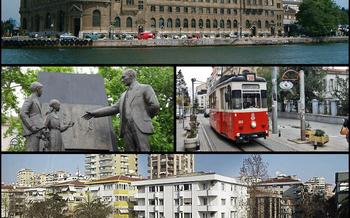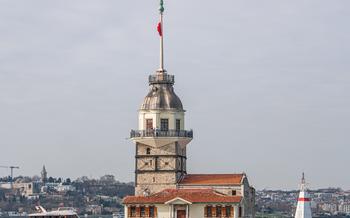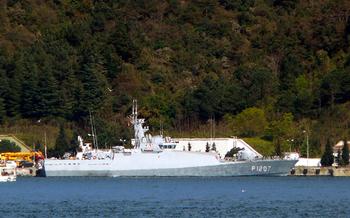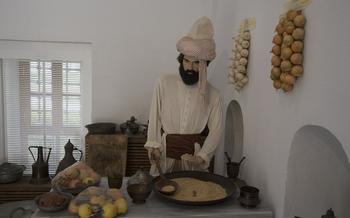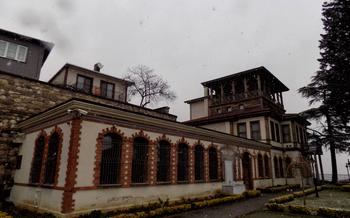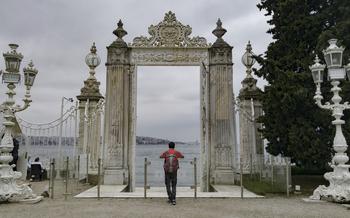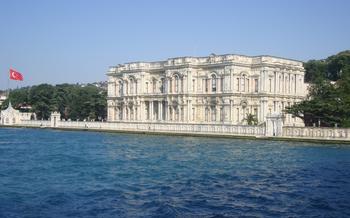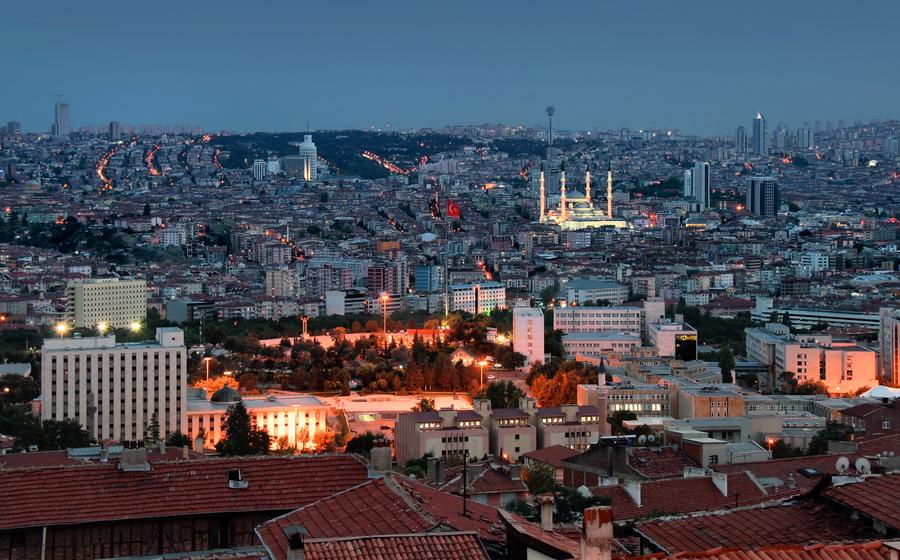
Samuel Pasha Mansion
- Samuel Pasha Mansion: A Historical Gem in Ankara
- Location and Accessibility
- Visiting Hours and Fees
- Guided Tours
- Exploring the Mansion's Interior
- The Mansion's Garden
- Samuel Pasha: A Brief Biography
- Historical Importance of the Mansion
- Architectural Style and Design
- Current Use as a Museum
- Personal Anecdotes and Stories
- Things to Do Nearby
- Cultural Significance
- Photo Opportunities
- Insider Tip: Hidden Gem
Samuel Pasha Mansion: A Historical Gem in Ankara
Nestled in the heart of Ankara, the Samuel Pasha Mansion stands as a testament to the city's vibrant history and cultural heritage. Built in the late 19th century, this opulent mansion served as the residence of Samuel Pasha, a prominent Armenian-Ottoman diplomat and military figure who played a pivotal role in shaping Turkey's diplomatic relations during the Crimean War.
The mansion's grandeur is evident in its intricate architectural details, blending Ottoman and European influences. Its facade boasts ornate carvings, arched windows, and a stately entrance that hints at the stories held within its walls. Today, this magnificent edifice serves as a museum, inviting visitors to step back in time and explore the life and legacy of Samuel Pasha, as well as the mansion's significance in Ankara's historical narrative.
Location and Accessibility
The Samuel Pasha Mansion is conveniently located in the heart of Ankara, at Ali Rıza Paşa Sokak 2, Gazi Osmanpaşa, Altındağ. Easily accessible by public transportation, visitors can take the Ankaray line and get off at the Kurtuluş station, which is a short walk from the mansion. Several bus lines also stop nearby, including the 35A, 36A, and 41.
For those who prefer to drive, there is limited street parking available in the surrounding area. However, it is important to note that the streets can be narrow and congested, so it is recommended to arrive early or consider using a taxi or ride-sharing service.
Visiting Hours and Fees
The Samuel Pasha Mansion is open to the public every day except Mondays. Visiting hours are from 9:00 AM to 5:00 PM. Admission fees are quite reasonable, with regular tickets costing around 15 Turkish Lira (approximately 2 USD) for adults. Students and seniors can enjoy discounted rates of 10 Turkish Lira (approximately 5 USD) upon presenting valid identification. Entrance to the mansion is free of charge for children under the age of It's worth noting that these fees may be subject to change, so it's advisable to check the official website or contact the museum directly for the most up-to-date information.
Guided Tours
The Samuel Pasha Mansion offers guided tours to enhance the visitor's experience and provide deeper insights into its history and significance. These tours are available in various languages, including English, Turkish, and German, allowing visitors from different backgrounds to understand the mansion's story. The cost of a guided tour is typically included in the admission fee.
To book a guided tour, visitors can either make a reservation in advance or inquire upon arrival at the mansion. It is advisable to book in advance, especially for groups or during peak seasons, to secure a spot and avoid disappointment. The mansion's staff is knowledgeable and passionate about its history, ensuring that visitors receive an informative and engaging tour experience.
Exploring the Mansion's Interior
Step inside the Samuel Pasha Mansion, and you'll be transported back in time to an era of opulence and elegance. The mansion's interior is a treasure trove of history, with each room telling its own story.
The grand entrance hall sets the tone for the rest of the mansion. With its soaring ceilings, marble floors, and intricate chandeliers, it's easy to imagine the many dignitaries and guests who have graced these halls.
One of the most impressive rooms in the mansion is the grand ballroom. This vast space was once used for lavish parties and receptions. Today, it's a popular venue for weddings and other special events. The ballroom features a stunningly detailed ceiling, parquet floors, and floor-to-ceiling windows that offer breathtaking views of the city.
Another highlight of the mansion is the library. This intimate space is lined with shelves of books, creating a cozy and inviting atmosphere. Samuel Pasha was a voracious reader, and his personal library reflects his wide-ranging interests in history, politics, and literature.
The mansion's bedrooms are equally impressive, each with its own unique character. The master bedroom features a four-poster bed, antique furniture, and a private balcony overlooking the garden. Other bedrooms are decorated in a variety of styles, from traditional Ottoman to modern European.
As you explore the mansion's interior, be sure to take note of the many personal belongings of Samuel Pasha that are on display. These include his medals, uniforms, and other memorabilia from his military and diplomatic career.
The Mansion's Garden
Adjoining the opulent interior of the Samuel Pasha Mansion is a serene and inviting garden that offers a tranquil respite from the bustling city. Originally designed to complement the architectural style of the mansion, the garden has been meticulously maintained over the years, preserving its charm and historical significance.
The layout of the garden is a testament to the harmonious blend of Ottoman and European influences that define the mansion. Visitors are greeted by a symmetrical arrangement of flower beds, each adorned with a vibrant array of seasonal blooms, creating a kaleidoscope of colors that captivates the eye. The flower beds are interspersed with manicured hedges and topiaries, adding structure and definition to the garden.
Beyond the flower beds, a series of gravel paths meander through the garden, inviting visitors to explore its hidden corners. These paths lead to cozy seating areas tucked away among the lush greenery, providing the perfect spot to relax and soak in the tranquility of the surroundings.
The variety of plants and flowers found in the garden is truly impressive, showcasing the region's rich botanical diversity. Visitors can admire the delicate beauty of roses, the vibrant hues of azaleas, and the fragrant aroma of jasmine. The garden also features an assortment of fruit trees, providing a sweet treat for visitors during the summer months.
One of the most captivating aspects of the garden is its peaceful atmosphere. Sheltered from the hustle and bustle of the city, the garden offers a serene retreat where visitors can escape the stresses of everyday life and immerse themselves in the tranquility of nature. The gentle sound of birdsong and the rustling of leaves in the breeze create a symphony of sounds that enhance the peaceful ambiance.
Whether you seek a place to relax and recharge or simply want to admire the beauty of nature, the garden of the Samuel Pasha Mansion is an oasis of tranquility that offers a delightful experience for visitors of all ages.
Samuel Pasha: A Brief Biography
Samuel Pasha, born Samuel Benjamin Schwitzer in 1824 in London, England, was a remarkable figure in Turkish history. His early life was shrouded in mystery, with little known about his childhood and education. However, his military career took off when he joined the British Army and fought in the Crimean War, where he distinguished himself through his bravery and strategic thinking.
Pasha's involvement in the Crimean War brought him to the attention of the Ottoman Empire, which was seeking talented military leaders to modernize its armed forces. In 1856, he was invited to serve as a military advisor to the Ottoman army, where he quickly rose through the ranks and became a trusted confidant of Sultan Abdulmejid I.
His military prowess and diplomatic skills were instrumental in strengthening the Ottoman Empire's position during a time of great political and military upheaval. Pasha played a crucial role in modernizing the Ottoman army, introducing new tactics and strategies that helped the empire withstand various conflicts and challenges.
Beyond his military achievements, Pasha also served as a diplomat, representing the Ottoman Empire in various international negotiations and conferences. His fluency in multiple languages and his deep understanding of European politics made him an invaluable asset to the empire.
Samuel Pasha's legacy extends far beyond his military and diplomatic contributions. He became a symbol of cultural exchange and cooperation between Turkey and Europe, bridging the gap between two distinct worlds. His dedication to Turkey and his unwavering commitment to its progress earned him the respect and admiration of both his contemporaries and future generations.
Historical Importance of the Mansion
The Samuel Pasha Mansion holds significant historical importance as it dates back to the Ottoman period. Constructed during the reign of Sultan Abdülmecid in the mid-19th century, the mansion initially served as a residence for foreign ambassadors and dignitaries visiting the Ottoman capital. This reflects the strategic role of Ankara as a center of diplomacy and international relations during that era. Over the years, the mansion witnessed numerous historical events and played a crucial role in facilitating cultural exchange and diplomatic negotiations between the Ottoman Empire and foreign powers. Its rich history and association with prominent figures make it a valuable heritage site in Turkey.
Architectural Style and Design
The Samuel Pasha Mansion showcases a captivating blend of Ottoman and European architectural styles, reflecting the fusion of cultures that characterized the era of its construction. The exterior façade is adorned with intricate carvings, decorative tiles, and arched windows, reminiscent of traditional Ottoman architecture. These elements are complemented by the symmetrical design and classical proportions that are hallmarks of European architecture, particularly the Neoclassical style popular in the mid-19th century.
The mansion's interior is equally impressive, featuring spacious rooms with high ceilings and large windows that allow for ample natural light. The grand staircase, with its ornate balustrade and intricate carvings, is a testament to the craftsmanship of the era. The rooms are decorated with a combination of Ottoman and European furnishings, creating a unique and eclectic atmosphere. The mansion's overall design reflects the sophisticated tastes and cosmopolitan outlook of Samuel Pasha, a man who embraced the best of both worlds.
Current Use as a Museum
In the 1980s, the Samuel Pasha Mansion underwent a significant transformation, evolving into a museum that preserves and showcases the mansion's rich history and cultural significance. The museum's collection boasts a diverse range of artifacts, documents, and personal belongings that provide visitors with a deeper insight into the life of Samuel Pasha and the era in which he lived.
Educational programs and exhibitions are regularly organized at the museum, offering visitors an interactive and immersive learning experience. These programs delve into various aspects of Turkish history, diplomacy, and cultural exchange, shedding light on the mansion's role in shaping Turkey's relations with other nations.
Through its transformation into a museum, the Samuel Pasha Mansion has become a valuable resource for researchers, historians, and anyone interested in exploring Turkey's rich cultural heritage. It serves as a living testament to the enduring legacy of Samuel Pasha and his contributions to the nation's development.
Personal Anecdotes and Stories
Visitors to the Samuel Pasha Mansion often share their unique experiences and memories. One visitor recalled a particularly memorable encounter with a museum guide who brought the history of the mansion to life with vivid storytelling. The guide shared anecdotes about Samuel Pasha's diplomatic missions and his interactions with world leaders, making the visit all the more engaging.
Another visitor recounted an interesting legend associated with the mansion. It is said that Samuel Pasha had a secret room hidden behind a bookcase, where he would meet with foreign dignitaries and conduct confidential negotiations. The existence of this secret room has never been confirmed, but it adds an air of mystery and intrigue to the mansion's history.
Samuel Pasha himself left behind a wealth of personal anecdotes and stories that provide a glimpse into his life and character. In his memoirs, he recounted his adventures during the Crimean War, his encounters with foreign dignitaries, and his thoughts on the changing political landscape of the Ottoman Empire. These anecdotes offer a fascinating insight into the mind of a man who played a significant role in shaping Turkey's history.
Things to Do Nearby
Beyond exploring the Samuel Pasha Mansion, visitors can immerse themselves in the vibrant atmosphere of Ankara by venturing into the surrounding area. Just a short walk away, the Çengelhan Rahmi M. Koç Museum showcases a remarkable collection of vintage cars, motorcycles, and industrial machinery, offering a glimpse into Turkey's rich transportation and technological heritage.
For those seeking a culinary adventure, the Samur Hotel is a renowned local gem, serving up traditional Turkish delicacies in an elegant and welcoming setting. Its rooftop terrace boasts panoramic views of the city, making it the perfect spot to savor authentic flavors while enjoying breathtaking vistas.
Shopaholics can indulge in a delightful shopping spree at the Tunalı Hilmi Caddesi, a bustling street lined with an array of boutiques, shops, and shopping malls. From local artisans' handicrafts to international brands, this vibrant thoroughfare caters to every taste and budget.
Nature enthusiasts can find respite and tranquility at the Gençlik Park, a sprawling green oasis in the heart of the city. With its serene lake, lush gardens, and various recreational facilities, the park offers a welcome escape from the hustle and bustle of urban life.
Cultural Significance
The Samuel Pasha Mansion stands as a testament to the rich cultural heritage of Ankara. Its existence symbolizes the harmonious coexistence of Turkish and European influences that have shaped the city's identity over the centuries. The mansion's architectural style, interior design, and historical significance all contribute to its cultural importance.
As a former residence for foreign ambassadors, the mansion played a crucial role in facilitating diplomatic relations and cultural exchange between Turkey and other nations. It served as a meeting ground for diplomats, politicians, and intellectuals from diverse backgrounds, fostering mutual understanding and cooperation.
Today, the mansion's transformation into a museum further enhances its cultural significance. The museum's collection of artifacts and documents provides visitors with a glimpse into the mansion's past and its role in Turkish history. Educational programs and exhibitions held at the museum contribute to the preservation and promotion of Ankara's cultural heritage.
The Samuel Pasha Mansion is not merely a historical landmark but also a symbol of Ankara's vibrant cultural identity. It represents the city's openness to foreign influences and its commitment to preserving its rich past. Visitors to the mansion can immerse themselves in the cultural tapestry that has shaped Ankara into the diverse and dynamic city it is today.
Photo Opportunities
The Samuel Pasha Mansion is a treasure trove of photo opportunities, both inside and out. The intricate architectural details, the lush garden, and the personal belongings of Samuel Pasha provide a wealth of subjects to capture.
Instagrammable Spots
The mansion's courtyard is a particularly popular spot for photos, with its colorful tiles, ornate fountain, and surrounding greenery. The grand staircase, with its sweeping balustrade and intricate carvings, is another must-snap spot.
For a more intimate shot, head to the mansion's garden. The vibrant flowers, the shady trees, and the tranquil atmosphere create a picturesque backdrop for your photos.
Tips for Capturing the Best Shots
To make the most of your photo opportunities at the Samuel Pasha Mansion, here are a few tips:
- Use natural light whenever possible. The mansion's interiors are often dimly lit, so using the natural light that streams in through the windows will help you capture brighter, more vibrant photos.
- Experiment with different angles. Don't just take photos from eye level. Try shooting from above or below to create more dynamic compositions.
- Use a tripod for stability. This will help you avoid blurry photos, especially when shooting in low-light conditions.
- Edit your photos afterwards. Once you've taken your photos, take some time to edit them to improve the colors, contrast, and sharpness.
Sharing Photos on Social Media
Once you've captured your perfect shots, be sure to share them on social media! Use the hashtag #SamuelPashaMansion to connect with other travelers and share your experiences.
Insider Tip: Hidden Gem
Beyond the well-trodden paths of the Samuel Pasha Mansion, there lie hidden gems waiting to be discovered. As you explore the mansion's sprawling grounds, keep an eye out for a secluded corner tucked away from the main thoroughfares. Here, you'll find a charming tea garden, where you can escape the hustle and bustle and savor a moment of tranquility. Sip on traditional Turkish tea, indulge in delectable pastries, and let the gentle breeze caress your senses as you soak in the serene atmosphere.
For those seeking a unique and immersive experience, venture into the mansion's basement. This often-overlooked area houses a treasure trove of artifacts and documents that shed light on Samuel Pasha's life and the history of the mansion. From personal letters and military records to rare photographs and intricate maps, these hidden gems offer a glimpse into the past that is sure to captivate history buffs and curious minds alike.
To truly make the most of your visit, consider exploring the mansion during off-peak hours. By avoiding the crowds that typically flock to the mansion during the daytime, you'll have the opportunity to wander through the rooms at your own pace, soak in the ambiance, and fully appreciate the exquisite details that adorn every corner. Whether you're an early bird or a night owl, the mansion's extended hours provide ample opportunity for a serene and intimate experience.

